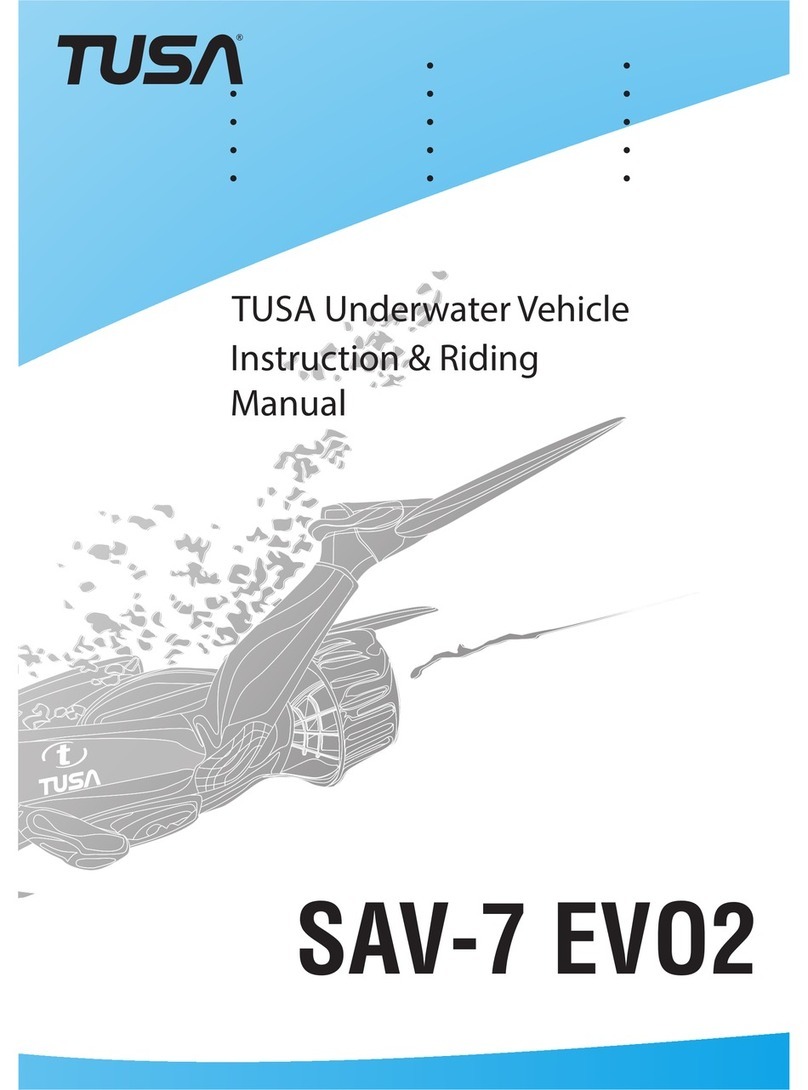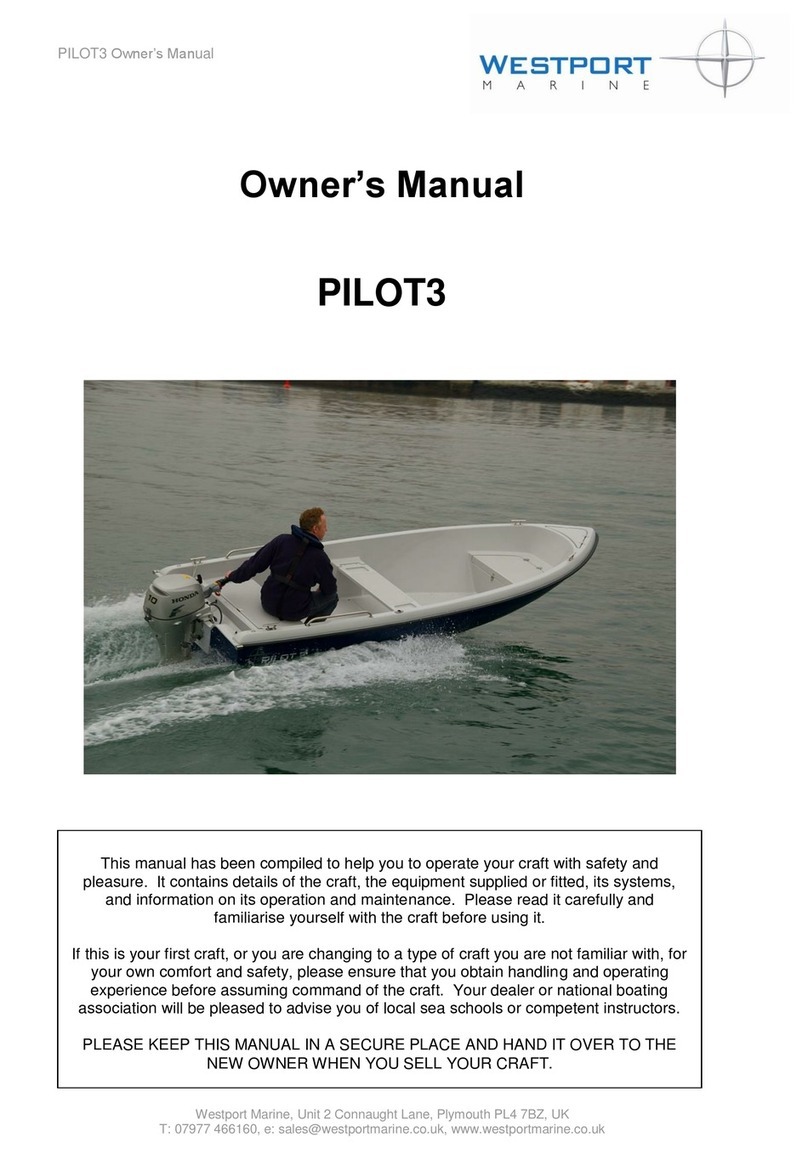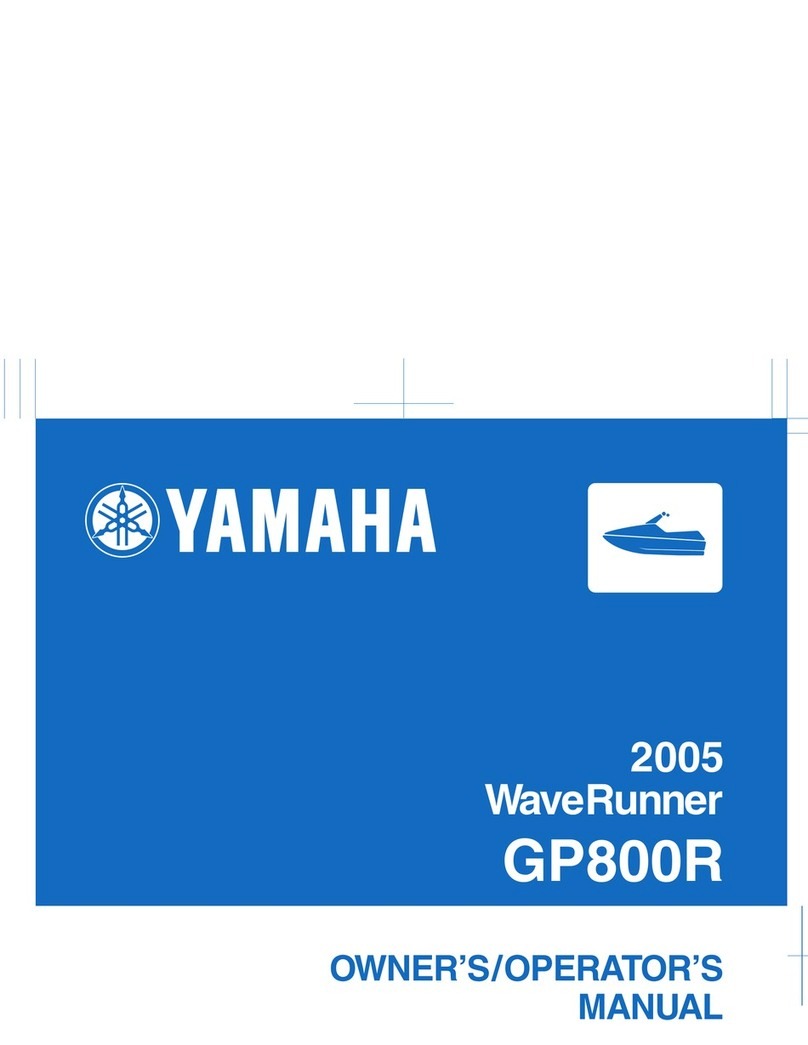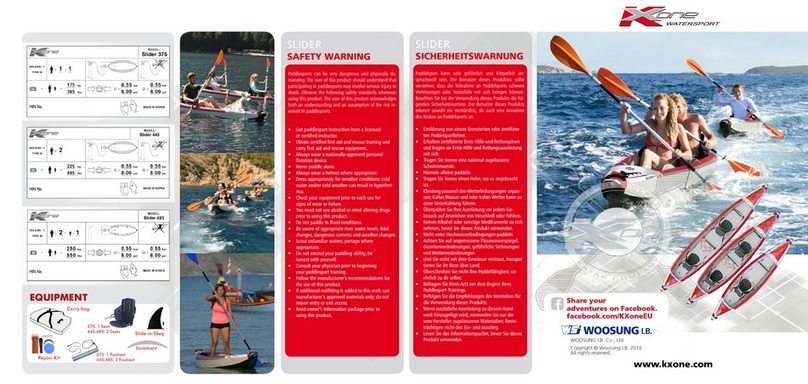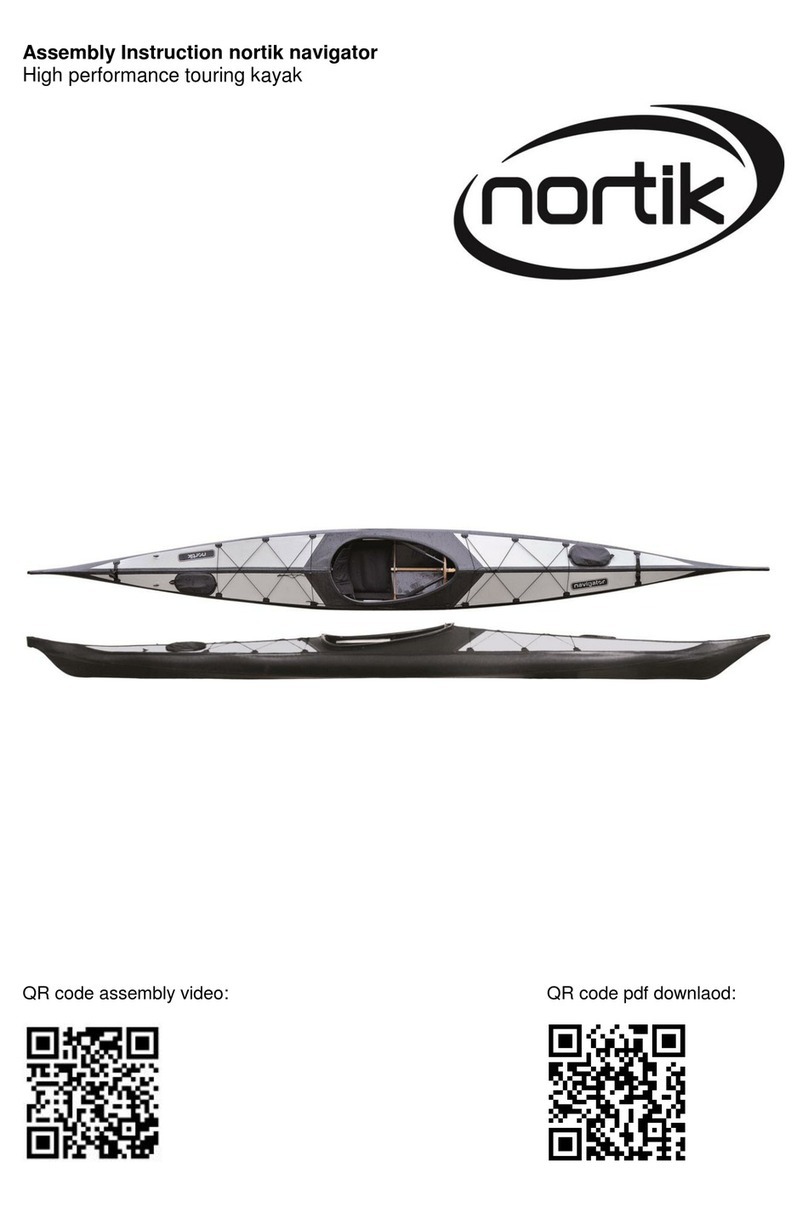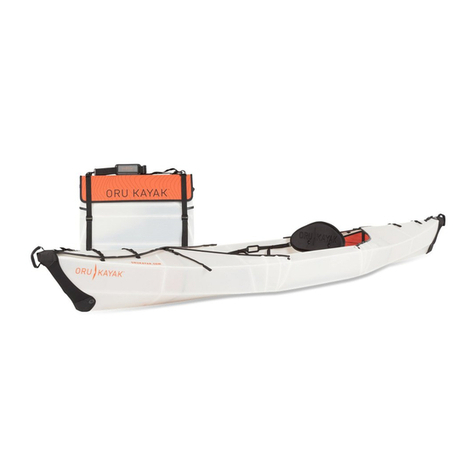Crevalle Boats 33 CSF User manual

Crevalle 33 CSF
Owner’s Manual

2

3
TABLE OF CONTENTS
TABLE OF CONTENTS .......................................................................................................... 3
SAFETY INFORMATION ........................................................................................................ 7
BOAT INFORMATION .......................................................................................................... 9
INTRODUCTION & IMPORTANT INFORMATION .......................................................................11
OWNER / OPERATOR INFORMATION .....................................................................................13
Chapter 1:
SAFETY EQUIPMENT
1.1 General .....................................................................................................................15
1.2 Engine Alarms ............................................................................................................15
1.3 Neutral Safety Switch ..................................................................................................15
1.4 Engine Stop Switch .....................................................................................................15
1.5 Required Safety Equipment ..........................................................................................16
1.6 Bilge & Fuel Fires ........................................................................................................17
1.7 First Aid.....................................................................................................................18
1.8 Additional Safety Equipment.........................................................................................18
1.9 Caution & Warning Labels.............................................................................................20
Chapter 2:
OPERATION
2.1 General .....................................................................................................................21
2.2 Rules of the Road........................................................................................................21
2.3 Pre-Cruise Check ........................................................................................................24
2.4 Operating Your Boat ....................................................................................................25
2.5 Docking, Anchoring & Mooring ......................................................................................26
2.6 Controls, Steering, or Propulsion System Failure..............................................................28
2.7 Collision.....................................................................................................................28
2.8 Grounding, Towing & Rendering Assistance .....................................................................29
2.9 Flooding or Capsizing...................................................................................................29
2.10 Fishing.....................................................................................................................29
2.11 Man Overboard .........................................................................................................30
2.12 Water Skiing & Wakeboarding .....................................................................................30
2.13 Trash Disposal ..........................................................................................................32
2.14 Yacht Certication Plate..............................................................................................32
2.15 Trailering Your Boat ...................................................................................................33
Chapter 3:
PROPULSION SYSTEM
3.1 General .....................................................................................................................35
3.2 Drive System Corrosion ...............................................................................................35
3.3 Engine Lubrication.......................................................................................................36
3.4 Engine Cooling System ................................................................................................36
3.5 Propellers ..................................................................................................................36
3.6 Performance Issues & Propellers ...................................................................................36
3.7 Engine Instrumentation ...............................................................................................38

4
TABLE OF CONTENTS
Chapter 4:
HELM CONTROL SYSTEMS
4.1 General .....................................................................................................................41
4.2 Engine Throttle & Shift Controls ....................................................................................41
4.3 Neutral Safety Switch ..................................................................................................42
4.4 Engine Power Tilt & Trim ..............................................................................................43
4.5 Engine Stop Switch .....................................................................................................44
4.6 Steering System .........................................................................................................45
4.7 Joystick Controls.........................................................................................................47
4.8 Trim Tabs ...................................................................................................................48
4.9 Control Systems Maintenance .......................................................................................49
Chapter 5:
FUEL SYSTEM
5.1 Gasoline Fuel Systems .................................................................................................51
5.2 Engine Fuel Delivery System.........................................................................................52
5.3 Fueling Instructions.....................................................................................................53
5.4 Fuel System Maintenance.............................................................................................54
Chapter 6:
ELECTRICAL SYSTEM
6.1 General .....................................................................................................................55
6.2 12 Volt DC System .....................................................................................................55
6.3 Batteries & Battery Switches.........................................................................................56
6.4 Parallel Switch & Dead Batteries....................................................................................57
6.5 Ignition Switch Panels..................................................................................................58
6.6 12 volt Accessory Switch Panels ....................................................................................60
6.7 DC Circuit Breakers ....................................................................................................66
6.8 Engine Control Systems Circuit Protection ............................................................................... 67
6.9 Accessory Fuse Panels .................................................................................................67
6.10 Digital Switching System Circuit Protection.................................................................................. 68
6.11 36 volt Trolling Motor System......................................................................................69
6.12 DC Power Management ..............................................................................................70
6.13 120 Volt Battery Charging System .........................................................................................71
6.14 Electrical System Maintenance ....................................................................................73
Chapter 7:
FRESH WATER SYSTEM
7.1 General .....................................................................................................................75
7.2 Fresh Water System Operation......................................................................................75
7.3 Fresh Water System Maintenance..................................................................................77
Chapter 8:
RAW WATER SYSTEM
8.1 General .....................................................................................................................79
8.2 Priming the System .....................................................................................................79
8.3 Raw Water System Operation .......................................................................................80
8.4 Livewells....................................................................................................................81
8.5 Raw Water System Maintenance....................................................................................82

5
TABLE OF CONTENTS
Chapter 9:
DRAINAGE SYSTEM
9.1 General .....................................................................................................................85
9.2 Cockpit & Deck Drainage..............................................................................................85
9.3 Bilge Drainage ............................................................................................................86
9.4 Hardtop Drains ...........................................................................................................88
9.5 Head Compartment Drains ...........................................................................................88
9.6 Drainage System Maintenance ......................................................................................88
Chapter 10:
VENTILATION SYSTEM
10.1 Head Compartment Ventilation....................................................................................89
10.2 Windshield Ventilation ...............................................................................................90
10.3 Maintenance .............................................................................................................90
Chapter 11:
EXTERIOR EQUIPMENT
11.1 Deck Rails & Deck Hardware .......................................................................................91
11.2 Anchor & Rope Locker ................................................................................................92
11.3 Windlass & Bow Roller................................................................................................93
11.4 Hull .........................................................................................................................95
11.5 Cockpit Features ......................................................................................................97
11.6 Helm Seats & Tackle Prep Station .............................................................................105
11.7 Center Console .......................................................................................................107
11.8 Hardtop ................................................................................................................109
11.9 Aftermarket Hardtop or Tower ..................................................................................110
Chapter 12:
INTERIOR EQUIPMENT
12.1 Head Compartment .................................................................................................111
12.2 Porcelain Marine Toilet .............................................................................................113
12.3 Head System Holding Tank .......................................................................................114
Chapter 13:
ROUTINE MAINTENANCE
13.1 Exterior Hull & Deck ................................................................................................117
12.2 Upholstery, Canvas & Enclosures ...............................................................................120
12.3 Interior .................................................................................................................122
12.4 Bilge, Pumps & Components .....................................................................................122
12.5 Engine & Fuel .........................................................................................................123
12.6 Drainage System.....................................................................................................123
Chapter 14:
SEASONAL MAINTENANCE
14.1 Storage & Lay-up ....................................................................................................125
14.2 Freshwater System Winterizing .................................................................................126
14.3 Raw Water System Winterizing..................................................................................127
14.4 Recommissioning ....................................................................................................129

6
TABLE OF CONTENTS
Appendix A:
SCHEMATICS ..................................................................................................................131
Viewing Your Drawing Set .................................................................................................131
Seastar DCM...................................................................................................................132
DCM/ Wet Sounds Assembly 1...........................................................................................133
DCM/ Wet sounds Assembly 2 ...........................................................................................134
DCM/ JL Audio Assembly 1................................................................................................135
DCM/ JL Audio Assembly 2................................................................................................136
MDP Battery Switch Panel .................................................................................................137
Hull Harness ...................................................................................................................138
Port Deck Harness ...........................................................................................................139
Starboard Deck Harness ...................................................................................................140
Hardtop Harness .............................................................................................................141
Console Harness..............................................................................................................142
Helm Switch Panel ...........................................................................................................143
Speaker Connector Harness Kit .........................................................................................144
Trim Tab Interface Harness ...............................................................................................145
Appendix B:
DCM User Manual & Trouble Shooting Guide ........................................................................147
Appendix C:
MAINTENANCE LOG .........................................................................................................167
Appendix D:
BOATING ACCIDENT REPORT ............................................................................................169
Appendix E:
FLOAT PLAN....................................................................................................................173
Appendix F:
GLOSSARY OF TERMS ......................................................................................................175
Appendix G:
TROUBLESHOOTING GUIDE ..............................................................................................181
Appendix H:
SPECIFICATIONS.............................................................................................................185

7
SAFETY INFORMATION
State of California Safety Requirements
WARNING
PROPOSITION 65
OPERATING, SERVICING AND MAINTAINING A RECREATIONAL MARINE VESSEL
CAN EXPOSE YOU TO CHEMICALS INCLUDING ENGINE EXHAUST, CARBON
MONOXIDE, PHTHALATES, AND LEAD, WHICH ARE KNOWN TO THE STATE OF
CALIFORNIATO CAUSE CANCERAND BIRTH DEFECTS OR OTHER REPRODUCTIVE
HARM. TO MINIMIZE EXPOSURE, AVOID BREATHING EXHAUST, SERVICE YOUR
VESSEL IN A WELL-VENTILATED AREA AND WEAR GLOVES OR WASH YOUR
HANDS FREQUENTLY WHEN SERVICING THIS VESSEL. FOR MORE INFORMATION
GO TO WWW.P65WARNING.CA.GOV/MARINE.
California Health & Safety Code §§ 25249.5-.13
State of California Emission Requirements
Your boat may be equipped with an engine that meets the special requirements outlined by the Cali-
fornia Air Resources Board (CARB). If so, the engine is designed to meet strict requirements and the
boat will have a special tag and one of the following labels axed to it.
The tag and the label are required by CARB. The label has 1, 2, 3 or 4 stars and must be axed to
your boat if it is to be operated in the state of California and/or bordering waters. For more informa-
tion visit: http://www.arb.ca.gov.

8
SAFETY INFORMATION
DANGER
WARNING
CAUTION
Your Crevalle owner’s manual has been written to include a number of safety instructions to assure
the safe operation and maintenance of your boat. These instructions are in the form of DANGER,
WARNING and CAUTION statements. The following denitions apply:
IMMEDIATE HAZARDS WHICH WILL RESULT IN SEVERE
PERSONAL INJURY OR DEATH.
HAZARDS OR UNSAFE PRACTICES WHICH COULD
RESULT IN SEVERE PERSONAL INJURY OR DEATH.
HAZARDS OR UNSAFE PRACTICES WHICH COULD
RESULT IN MINOR PERSONAL INJURY OR PRODUCT AND
PROPERTY DAMAGE.
All instructions given in this book are as seen from the stern looking toward the bow, with starboard
being to your right and port to your left. A glossary of boating terms is included.
IMPORTANT NOTE: Your boat uses an internal combustion engine and ammable fuel. Every pre-
caution has been taken by Crevalle to reduce the risks associated with possible injury and damage
from re or explosion, but your own precaution and good maintenance procedures are necessary in
order to enjoy safe operation of your boat.

9
All information, illustrations and specications contained in this manual are based on the
latest product information available at the time of publication. Crevalle Boats reserves
the right to make changes at anytime, without notice, in colors, materials, equipment,
specications and models.
Please ll out the following information section and leave it in your Crevalle owner’s manual.
This information will be important for you, your dealer and/or Crevalle service personnel
to know, if you may need to call them for technical assistance or service.
BOAT INFORMATION
PHONE:
REPRESENTATIVE:
NOTES
NAME:
DEALER/PHONE:
ADDRESS:
SERVICE MANAGER:
ADDRESS:
SALESMAN:
DEALER CREVALLE
MODEL:
PURCHASE DATE:
IGNITION KEYS #:
DRAFT:
HULL SERIAL #:
DELIVERY DATE:
REGISTRATION #:
WEIGHT:
TRAILER
OPTIONS
MAKE:
PORT SERIAL #:
MODEL:
STARBOARD SERIAL #:
SERIAL #:
MAKE: MODEL:
GVWR:
PROPELLERS
MAKE:
DIAMETER/PITCH:
TIRE SIZE:
ENGINES
BLADES:
SHAFT:
BOAT
E-MAIL:
DEALER E-MAIL:
BEAM: VERTICAL CLEARANCE:
DOOR KEYS #:

10
NOTES

11
All instructions given in this book are as seen from
the stern looking toward the bow with starboard
being to your right and port to your left. The
information and precautions listed in this manual
are not all inclusive. It may be general in nature
in some cases and detailed in others and is de-
signed to provide you a basic understanding of
your Crevalle boat and some of the responsibilities
that go along with owning/operating your boat.
The suppliers of some of the major components
such as the engines, pumps and appliances,
provide their own owner’s manuals which have
been included with your boat. You should read
the information in this manual and the manuals of
other suppliers completely and have a thorough
understanding of all component systems and their
proper operation before operating your boat.
REMEMBER - IT IS YOUR RESPONSIBILITY TO ENSURE THAT
YOUR BOAT IS SAFE FOR YOU AND YOUR PASSENGERS.
ALWAYS EXERCISE GOOD COMMON SENSE WHEN
INSTALLING EQUIPMENT AND OPERATING THE BOAT.
Warranty And Warranty Registration Cards
The Crevalle Limited Warranty Statement is included
with your boat. It has been written to be clearly
stated and easily understood. If you have any ques-
tions after reading the warranty, please contact the
Crevalle Boats Customer Service Department
Crevalle, engine manufacturers and the suppliers
of major components maintain their own manufac-
turer’s warranty and service facilities. It is important
that you properly complete the warranty registration
cards included with your boat and engine and mail
them back to the manufacturer to register your
ownership. This should be done within 15 days
of the date of purchase and before the boat is put
into service. A form for recording this information
for your records is provided at the beginning of this
manual. This information will be important for you
and service personnel to know, if and when you may
need service or technical information.
The boat warranty registration requires the Hull
Identication Number “HIN” which is located on
the starboard side of the transom, just below the
rubrail. The engine warranty registration requires
the engine serial numbers. Please refer to the en-
gine owner’s manual for the location of the serial
numbers.
IMPORTANT:
The terms and conditions of the Crevalle Boats
Limited Warranty are outlined in the warranty
statement included with this manual. The manu-
facturer will automatically honor the warranty to
the original purchaser for 15 days from the date
of purchase. However, during that 15 day period,
owners must comply with the steps outlined in
the warranty statement to validate their warranty.
All boat manufacturers are required by the Federal
Boat Safety Act of 1971 to notify rst time own-
ers in the event any defect is discovered “which
creates a substantial risk of personal injury to
the public.” It is essential that we have your
warranty registration card complete with
your name and mailing address in our les so
that we can comply with the law if it should
become necessary.
Your Crevalle Boats Dealer will assist you in lling
in the hull number and other data required on your
Registration Card. Check to see that your card
is complete and signed. Detach and mail. Your
Warranty Registration Card will be added to our
permanent les.
Transferring the Limited Structural Warranty
For a transfer fee, Crevalle Boats will oer to ex-
tend a Transferable Limited Structural Hull War-
ranty to subsequent owners of Crevalle Boats.
Please refer to the Crevalle Limited Warranty
Statement for the terms and conditions of the
Transferable Limited Structural Hull Warranty and
the procedure to transfer the warranty.
Product Changes
Crevalle is committed to the continuous improve-
ment of our boats. As a result, some of the equip-
ment described in this manual or pictured in the
catalog may change or no longer be available.
All information, illustrations and specica-
tions contained in this manual are based on
the latest product information available at
the time of publication. Crevalle Boats re-
serves the right to make changes at anytime,
without notice, in colors, materials, equip-
ment, specications and models. If you have
questions about the equipment on your Crevalle,
please contact the Crevalle Boats Customer Ser-
vice Department.
INTRODUCTION & IMPORTANT INFORMATION

12
Service
All warranty repairs must be performed by an
authorized Crevalle Dealer. Should a problem
develop that is related to faulty workmanship or
materials, as stated in the Limited Warranty, you
should contact your Crevalle dealer to arrange
for the necessary repair. If you are not near your
dealer or another authorized Crevalle dealer or the
dealer fails to remedy the cause of the problem,
then contact Crevalle within 15 days.
Crevalle will not reimburse boat owners for
warranty repairs performed without prior
authorization provided in writing.
It is the boat owner’s responsibility to deliver
the boat to the dealer for warranty service.
INTRODUCTION & IMPORTANT INFORMATION

13
Registration And Numbering
Federal law requires that all undocumented ves-
sels equipped with propulsion machinery be regis-
tered in the State of principal use. A certicate of
number will be issued upon registering the boat.
These numbers must be displayed on your boat.
The owner/operator of a boat must carry a valid
certicate of number whenever the boat is in use.
When moved to a new State of principal use, the
certicate is valid for 60 days.
In order to be valid, the numbers must be installed
to the proper specications. Check with your
dealer or state boating authority for numbering
requirements. The Coast Guard issues the cer-
ticate of number in Alaska; all others are issued
by the state.
Insurance
In most States the boat owner is legally respon-
sible for damages or injuries he or someone else
operating the boat causes. Responsible boaters
carry adequate liability and property damage in-
surance for their boat. You should also protect the
boat against physical damage and theft. Some
States have laws requiring minimum insurance
coverage. Contact your dealer or state boating
authority for information on the insurance require-
ments in your boating area.
Reporting Boating Accidents
All boating accidents must be reported by the op-
erator or owner of the boat to the proper marine
law enforcement authority for the state in which
the accident occurred. Immediate notication is
required if a person dies or disappears as a result
of a recreational boating accident.
If a person dies or there are injuries requiring
more than rst aid, a formal report must be led
within 48 hours.
A formal report must be made within 10 days for
accidents involving more than $500.00 damage
or the complete loss of a boat.
A Boating Accident Report form is located near
the back of this manual to assist you in reporting
an accident. If you need additional information
regarding accident reporting, please call the Boat-
ing Safety Hotline, 800-368-5647.
Education
If you are not an experienced boater, we recom-
mend that the boat operator and other people
that normally accompany the operator, enroll in a
boating safety course. Organizations such as the
U.S. Power Squadrons, United States Coast Guard
Auxiliary, State Boating Authorities and the Ameri-
can Red Cross oer excellent boating educational
programs. These courses are worthwhile even for
experienced boaters to sharpen your skills or bring
you up to date on current rules and regulations.
They can also help in providing local navigational
information when moving to a new boating area.
Contact your dealer, State Boating Authority or the
Boating Safety Hotline, 800-368-5647 for further
information on boating safety courses.
Required Equipment
U.S. Coast Guard regulations require certain
equipment on each boat. The Coast Guard also
sets minimum safety standards for vessels and
associated equipment. To meet these standards
some of the equipment must be Coast Guard ap-
proved. “Coast Guard Approved Equipment” has
been determined to be in compliance with USCG
specications and regulations relating to perfor-
mance, construction or materials. The equipment
requirements vary according to the length, type
of boat and the propulsion system. Some of the
Coast Guard equipment is described in the Safety
Equipment chapter of this manual. For a more
detailed description, obtain “Federal Requirements
And Safety Tips For Recreational Boats” by con-
tacting the Boating Safety Hotline 800-368-5647
or your local marine dealer or retailer.
Some state and local agencies impose similar
equipment requirements on waters that do not fall
under Coast Guard jurisdiction. These agencies
may also require additional equipment that is not
required by the Coast Guard. Your dealer or local
boating authority can provide you with additional
information for the equipment requirements for
your boating area.
OWNER / OPERATOR INFORMATION

14
NOTES

15
1.1 General
Your boat and outboard engines have been
equipped with safety equipment designed to en-
hance the safe operation of the boat and to meet
U.S. Coast Guard safety standards. The Coast
Guard or state, county and municipal law enforce-
ment agencies require certain additional accessory
safety equipment on each boat. This equipment
varies according to length and type of boat and
type of propulsion. The accessory equipment typi-
cally required by the Coast Guard is described in
this chapter. Some local laws require additional
equipment. It is important to obtain “Federal
Requirements And Safety Tips for Recreational
Boats,” published by the Coast Guard and copies
of state and local laws, to make sure you have the
required equipment for your boating area.
Your boat is equipped with engine alarms. The
alarm systems are designed to increase your boat-
ing safety by alerting you to potentially serious
problems in the primary power system. Alarm
systems are not intended to lessen or replace good
maintenance and pre-cruise procedures.
This chapter also describes safety related equip-
ment that could be installed on your boat. This
equipment will vary depending on the type of
engines and other options installed by you or
your dealer.
1.2 Engine Alarms
Most outboard engines are equipped with an au-
dible alarm system mounted in the helm area that
monitors selected critical engine systems. The
alarm will sound if one of these systems begins to
fail. Refer to the engine owner’s manual for infor-
mation on the alarms installed with your engines.
If the alarm sounds:
• Immediately throttle the engines back to idle.
• Shift the transmissions to neutral.
• Monitor the engine gauges to determine the
cause of the problem.
• If necessary, shut o the engine and investigate
until the cause of the problem is found.
1.3 Neutral Safety Switch
Every control system has a neutral safety switch
incorporated into it. This device prohibits the
engines from being started while the shift levers
are in any position other than the neutral posi-
tion. If an engine will not start, slight movement
of the shift lever may be necessary to locate the
neutral position and disengage the safety cutout
switch. Control adjustments may be required to
correct this condition should it persist. See your
Crevalle dealer for necessary control adjustments.
Please refer to the Helm Control Systems chapter
for more information on the neutral safety switch.
1.4 Engine Stop Switch
Your boat is equipped with a engine stop switch
and lanyard. When the lanyard is pulled it will
engage the switch and shut o the engines. We
strongly recommend that the lanyard be attached
to the driver and the stop switch whenever the
engines are running. If the engines will not start,
it could be because the lanyard is not properly in-
serted into the engine stop switch. Always make
sure the lanyard is properly attached to the engine
stop switch before attempting to start the engine.
Notice:
In some states, a lanyard attached to the
driver at all times is required by law.
Throwable Device & Personal PFD
Chapter 1:
SAFETY EQUIPMENT

16
Safety Equipment
Notice:
You should carry an extra stop switch lan-
yard and instruct at least one other crew
member on the operation of the stop switch
and location of the extra lanyard.
1.5 Required Safety Equipment
Besides the equipment installed on your boat by
Crevalle, certain other equipment is required by
the U.S. Coast Guard to help ensure passenger
safety. Items like a sea anchor, working anchor,
extra dock lines, are pistol, life vests, a line per-
manently secured to your ring buoy, etc., could
at some time save your passengers’ lives or save
your boat from damage. Refer to the “Federal
Requirements And Safety Tips For Recreational
Boats” pamphlet for a more detailed description
of required equipment. You also can contact the
Coast Guard Auxiliary for information on boat
safety courses and brochures listing the Federal
equipment requirements. Also, check your local
and state regulations.
The Coast Guard Auxiliary oers a “Courtesy Ex-
amination.” This inspection will help ensure that
your boat is equipped with all of the necessary
safety equipment. The following is a list of the
accessory equipment required on your boat by the
U.S. Coast Guard:
Personal Flotation Devices (PFDs)
PFDs must be Coast Guard approved, in good
and serviceable condition and of appropriate size
for the intended user. Wearable PFDs must be
readily accessible, meaning you must be able to
put them on in a reasonable amount of time in
an emergency. Though not required, the Coast
Guard emphasizes that PFDs should be worn at
all times when the vessel is underway. Throwable
devices must be immediately available for use.
All Crevalle boats must be equipped with at least
one Type I, II or III PFD for each person onboard,
plus one throwable device (Type IV).
Notice:
Many state laws now require that children
13 years old and under must wear a PFD at
all times.
Anyone being towed on skis, wakeboards and
other water sports equipment is considered
a passenger on the boat and must wear a
Coast Guard approved life jacket at all times.
Visual Distress Signals
All boats used on coastal waters, the Great Lakes,
territorial seas and those waters connected di-
rectly to them, must be equipped with Coast Guard
approved visual distress signals. These signals
are either Pyrotechnic or Non-Pyrotechnic devices.
Pyrotechnic Visual Distress Signals:
Pyrotechnic visual distress signals must be Coast
Guard approved, in serviceable condition and
readily accessible. They are marked with a date
showing the service life, which must not have
expired. A minimum of three are required. Some
pyrotechnic signals meet both day and night use
requirements. They should be stored in a cool,
dry location. They include:
• Pyrotechnic red ares, hand held or aerial.
• Pyrotechnic orange smoke, hand-held or
oating.
• Launchers for aerial red meteors or parachute
ares.
WARNING
PYROTECHNICS ARE UNIVERSALLY RECOGNIZED AS
EXCELLENT DISTRESS SIGNALS. HOWEVER, THERE IS
POTENTIAL FOR INJURY AND PROPERTY DAMAGE IF NOT
PROPERLY HANDLED. THESE DEVICES PRODUCE A VERY
HOT FLAME AND THE RESIDUE CAN CAUSE BURNS AND
IGNITE FLAMMABLE MATERIAL. PISTOL LAUNCHED AND
HAND-HELD PARACHUTE FLARES AND METEORS HAVE
MANY CHARACTERISTICS OF A FIREARM AND MUST BE
HANDLED WITH CAUTION. IN SOME STATES THEY ARE
CONSIDERED A FIREARM AND PROHIBITED FROM USE.
ALWAYS BE EXTREMELY CAREFUL AND FOLLOW THE
MANUFACTURER’S INSTRUCTIONS EXACTLY WHEN USING
PYROTECHNIC DISTRESS SIGNALS.
Non-Pyrotechnic Devices
Non-Pyrotechnic visual distress signals must be
in serviceable condition, readily accessible, and
certied by the manufacturer as complying with
U.S. Coast Guard requirements. They include:
• Orange Distress Flag (Day use only)
The distress ag is a day signal only. It must
be at least 3 x 3 feet with a black square and
ball on an orange background. It is most
distinctive when attached and waved from a
paddle or boat hook.

17
Safety Equipment
• Electric Distress Light (Night use only)
The electric distress light is accepted for
night use only and must automatically ash
the international SOS distress signal. Under
“Inland Navigation Rules,” a high intensity
white light ashing at regular intervals from
50-70 times per minute is considered a
distress signal.
Sound Signaling Devices
The navigation rules require sound signals to be
made under certain circumstances. Recreational
vessels also are required to sound fog signals dur-
ing periods of reduced visibility. Therefore, you
must have some means of making an ecient
sound signal.
Navigation Lights
Recreational boats are required to display naviga-
tion lights between sunset and sunrise and other
periods of reduced visibility (fog, rain, haze, etc.)
Navigation lights are intended to keep other ves-
sels informed of your presence and course. Your
boat is equipped with navigation lights required by
the U.S. Coast Guard at the time of manufacture.
It is up to you to make sure they are operational
and turned on when required.
Fire Extinguishers
Boats over 26 feet are required
to carry one or two re extin-
guishers, depending on the
type of re extinguishers used.
Coast Guard approved re ex-
tinguishers are hand-portable,
either B-I or B-II classication
and have a specic marine type
mounting bracket. It is recom-
mended that the extinguishers
be mounted in a readily acces-
sible position.
Fire extinguishers require regu-
lar inspections to ensure that:
• Seals & tamper indicators are not broken or
missing.
• Pressure gauges or indicators read in the
operable range.
• There is no obvious physical damage,
corrosion, leakage or clogged nozzles.
Refer to the “Federal Requirements And Safety
Tips For Recreational Boats” pamphlet or contact
the Coast Guard Auxiliary, for information on the
type and size re extinguisher required for your
boat.
Refer to the information provided by the re ex-
tinguisher manufacturer for instructions on the
proper maintenance and use of your re extin-
guisher.
CAUTION
INFORMATION FOR HALON, AGENT FE-241 AND AGENT
FM 200 FIRE EXTINGUISHERS IS PROVIDED BY THE
MANUFACTURER. IT IS ESSENTIAL THAT YOU READ
THE INFORMATION CAREFULLY AND COMPLETELY
UNDERSTAND THE SYSTEM, IN THEORY AND OPERATION,
BEFORE USING YOUR BOAT.
1.6 Bilge & Fuel Fires
Fuel compartment and bilge res are very dan-
gerous because of the presence of gasoline in
the various components of the fuel system and
the possibility for explosion. You must make the
decision to ght the re or abandon the boat. If
the re cannot be extinguished quickly or it is too
intense to ght, abandoning the boat may be your
only option. If you nd yourself in this situation,
make sure all passengers have a life preserver on
and go over the side and swim well upwind of the
boat. This will keep you and your passengers well
clear of any burning fuel that could be released
and spread on the water as the boat burns or
in the event of an explosion. When clear of the
danger, check about and account for all those who
were aboard with you. Give whatever assistance
you can to anyone in need or in the water without
a buoyant device. Keep everyone together in a
group for morale and to aid rescue operations.
WARNING
GASOLINE CAN EXPLODE. IN THE EVENT OF A FUEL
COMPARTMENT OR BILGE FIRE, YOU MUST MAKE THE
DIFFICULT DECISION TO FIGHT THE FIRE OR ABANDON THE
BOAT. YOU MUST CONSIDER YOUR SAFETY, THE SAFETY
OF YOUR PASSENGERS, THE INTENSITY OF THE FIRE AND
THE POSSIBILITY OF AN EXPLOSION IN YOUR DECISION.

18
Safety Equipment
1.7 First Aid
It is the operator’s responsibility to be familiar
with the proper rst-aid procedures and be able
to care for minor injuries or illnesses of your pas-
sengers. In an emergency, you could be far from
professional medical assistance. We strongly
recommend that you be prepared by receiving
training in basic rst aid and CPR. This can be
done through classes given by the Red Cross or
your local hospital.
Your boat should also be equipped with at least a
simple marine rst-aid kit and a rst-aid manual.
The marine rst-aid kit should be designed for
the marine environment and be well supplied. It
should be accessible and each person onboard
should be aware of its location. As supplies are
used, replace them promptly. Some common
drugs and antiseptics may lose their strength
or become unstable as they age. Ask a medical
professional about the supplies you should carry
and the safe shelf life of prescription drugs or other
medical supplies that may be in your rst-aid kit.
Replace questionably old supplies whether they
have been used or not.
In many emergency situations, the Coast Guard
can provide assistance in obtaining medical advice
for treatment of serious injuries or illness. If you
are within VHF range of a Coast Guard Station,
make the initial contact on channel 16 and follow
their instructions.
1.8 Additional Safety Equipment
Besides meeting the legal requirements, prudent
boaters carry additional safety equipment. This
is particularly important if you operate your boat
oshore. You should consider the following items,
depending on how you use your boat.
Satellite EPIRBS
EPIRBs (Emergency Position Indicating Radio
Beacon) operate as part of a worldwide distress
system. When activated, EPIRBs will send distress
code homing beacons that allow Coast Guard
aircraft to identify and nd them quickly. The
satellites that receive and relay EPIRB signals are
operated by the National Oceanic and Atmospheric
Administration (NOAA) in the United States. The
EPIRB should be mounted and registered accord-
ing to the instructions provided with the beacon,
Typical First Aid Kit

19
Safety Equipment
so that the beacon’s unique distress code can be
used to quickly identify the boat and owner.
Marine Radio
A marine radio is the most eective method of
receiving information and requesting assistance.
VHF marine radios are used near shore and single
sideband radios are used for long range commu-
nication.
There are specic frequencies to use in an emer-
gency. The VHF emergency channel is 16 in
the United States. You should read the owners
manual for your radio and know how to use it in
an emergency or for normal operation. If you
hear a distress call you should assist or monitor
the situation until help is provided.
Additional Equipment to Consider:
Cell Phone Spare Anchor
Fenders Heaving Line
Mirror First Aid Kit
Tool Kit Flashlight & Batteries
Anchor Search light
Boat Hook Sunburn Lotion
Mooring Lines Ring Buoy or Boat Cushion
Binoculars Whistle or Horn
Extra Clothing Marine Hardware
Chart and Compass Spare Keys
Food & Water Spare Parts
Sunglasses Spare Propeller Hub Kits
Spare Propellers

20
Safety Equipment
1.9 Caution & Warning Labels
The caution and warning labels shown are ex-
amples of the labels that could be on your boat.
The actual labels and their location could vary on
your boat.
Caution and warning labels must remain legible for
the safety of you and your passengers. If a label
becomes missing or damaged it must be replaced.
Immediately contact your dealer or Crevalle Cus-
tomer Service for a replacement.
DANGER
CARBON MONOXIDE (CO) CAN CAUSE BRAIN
DAMAGE OR DEATH.
ENGINE AND GENERATOR EXHAUST
CONTAINS ODORLESS AND COLORLESS
MONOXIDE GAS.
CARBON MONOXIDE WILL BE AROUND THE
BACK OF THE BOAT WHEN THE ENGINES OR
GENERATORS ARE RUNNING.
MOVE TO FRESH AIR, IF YOU FEEL NAUSEA,
HEADACHE, DISSINESS, OR DROWSINESS.
WARNING
ROTATING PROPELLER MAY CAUSE
SERIOUS INJURY OR DEATH.
DO NOT APPROACH OR USE LADDER WHEN
ENGINE IS RUNNING.
WARNING
ROTATING PROPELLER MAY CAUSE SERIOUS
INJURYOR DEATH. SHUT OFF ENGINE WHEN
NEAR PERSONS IN THE WATER.
WARNING
CARBON MONOXIDE (CO) CAN CAUSE BRAIN
DAMAGE OR DEATH.
ENGINE AND GENERATOR EXHAUST
CONTAINS ODORLESS AND COLORLESS
CARBON MONOXIDE GAS.
SIGNS OF CARBON MONOXIDE POISONING
INCLUDE NAUSEA, HEADACHE,
DIZZINESS, DROWSINESS, AND LACK OF
CONSCIOUSNESS.
GET FRESH AIR IFANYONE SHOWS SIGNS OF
CARBON MONOXIDE POISONING.
SEE OWNER’S MANUAL FOR INFORMATION
REGARDING CARBON MONOXIDE POISONING.
WARNING
AVOID SERIOUS INJURY OR DEATH FROM
FIRE OR EXPLOSION RESULTING FROM
LEAKING FUEL. INSPECT SYSTEM FOR
LEAKS AT LEAST ONCE A YEAR.
Table of contents
Other Crevalle Boats Boat manuals
Popular Boat manuals by other brands

Reely
Reely 1432381 operating instructions
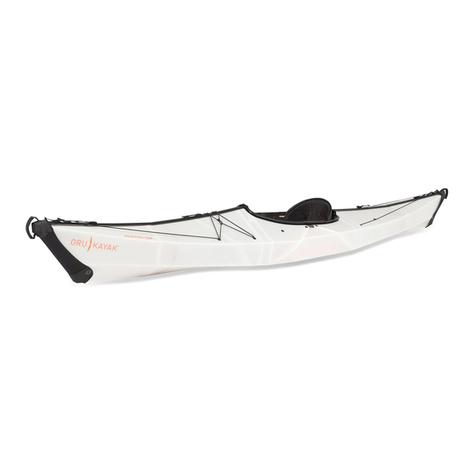
Oru Kayak
Oru Kayak BAY ST Assembly guide

Jeanneau
Jeanneau PRESTIGE 30 owner's manual
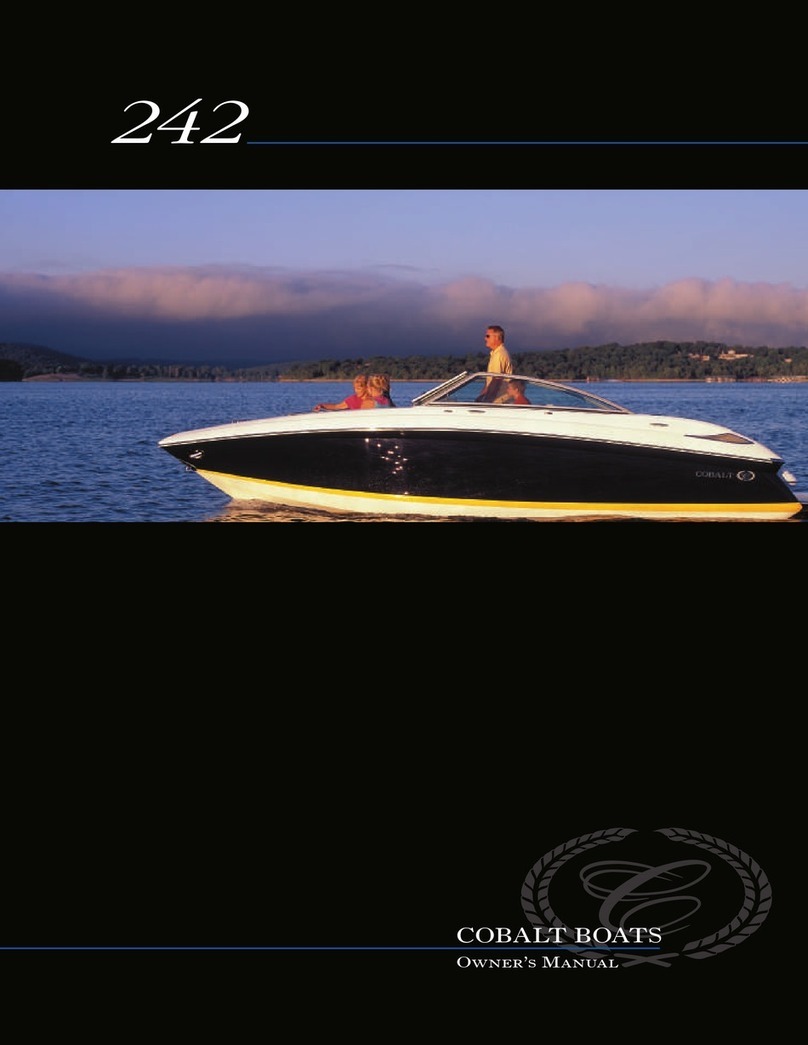
Cobalt Digital Inc
Cobalt Digital Inc 242 owner's manual
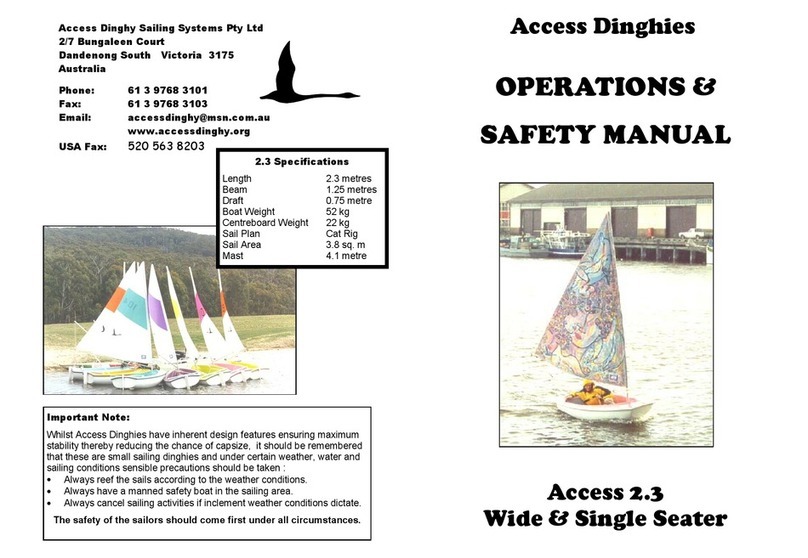
Access Dinghies
Access Dinghies access 2.3 Operation & safety manual
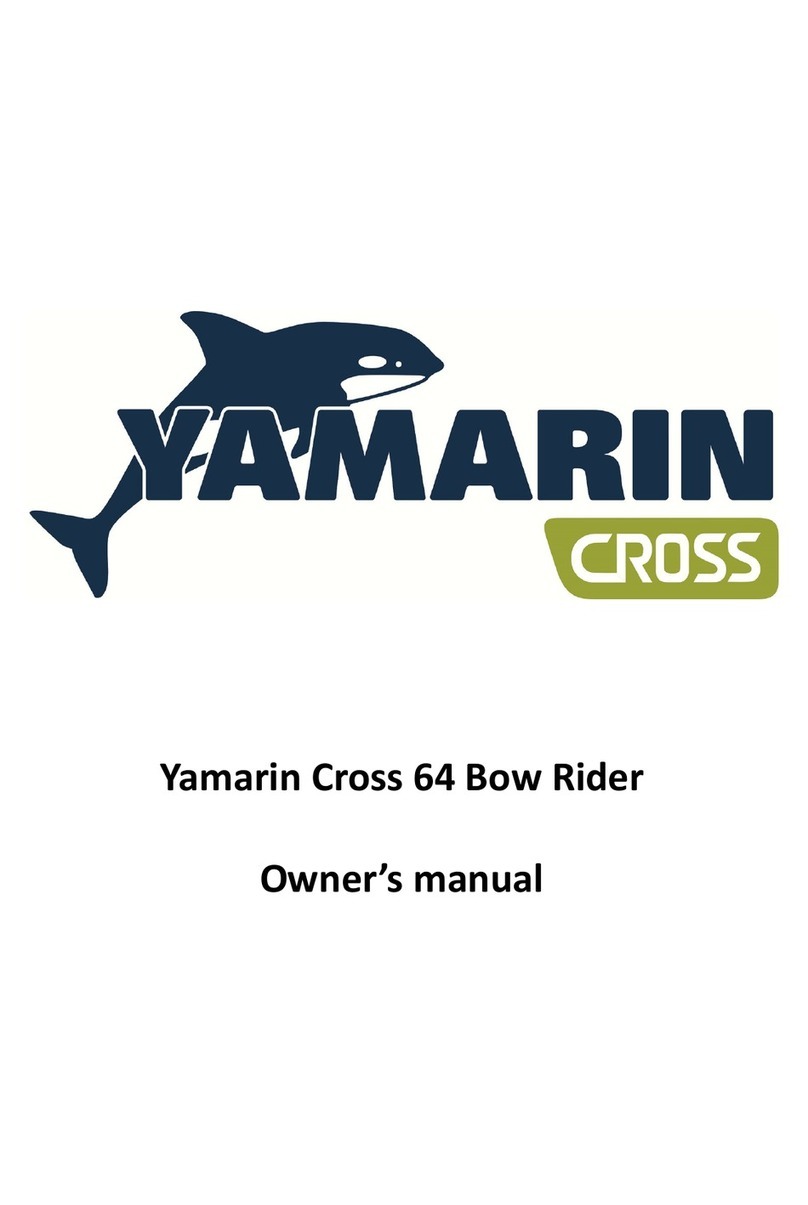
Yamarin Cross
Yamarin Cross 64 Bow Rider owner's manual

